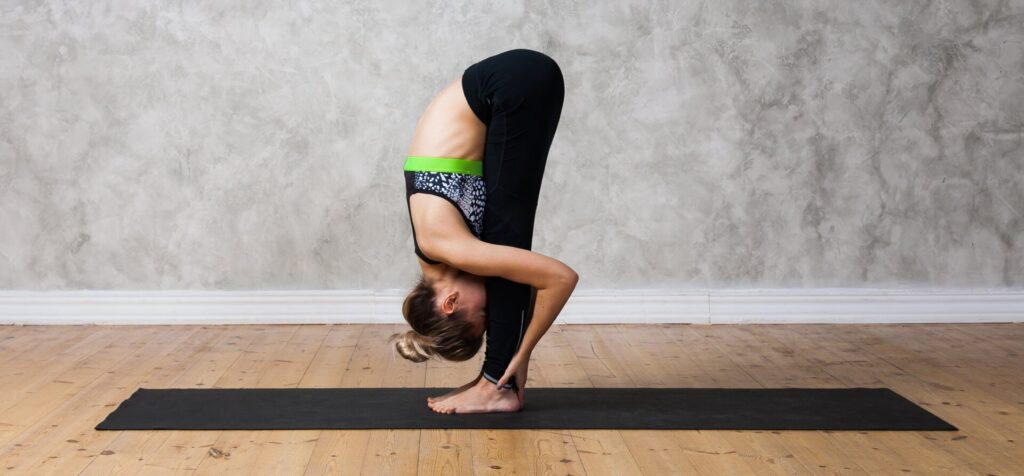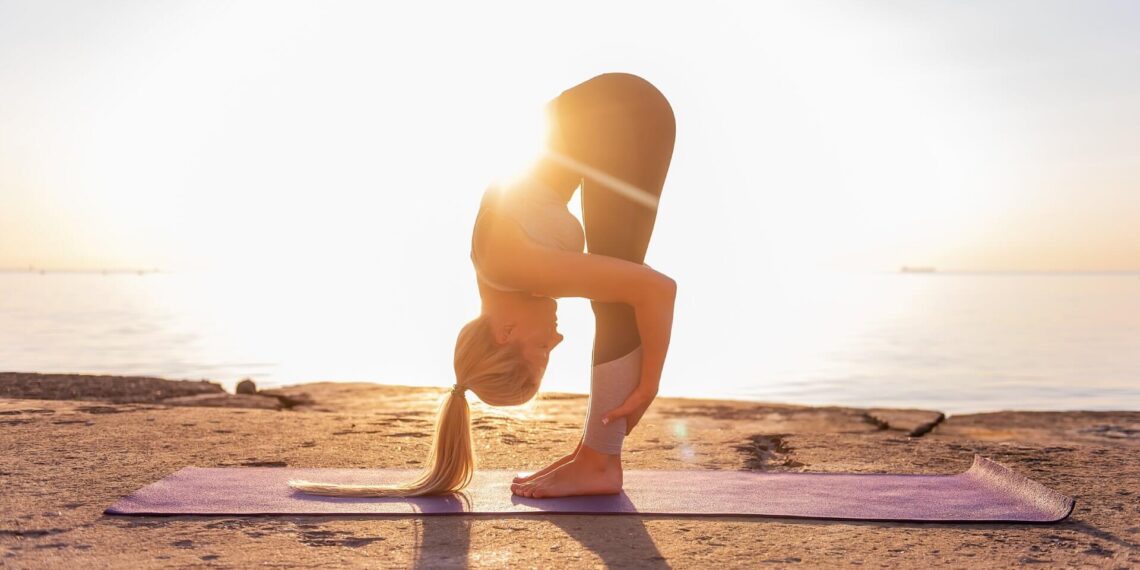“Uttanasana teaches us that the art of letting go can be the most profound act of self-care.”
Standing Forward Bend Uttanasana is a fundamental yoga pose that provides a range of physical and mental benefits. It’s a versatile posture that can be modified to suit practitioners of various levels, making it accessible to both beginners and those with more experience. Whether you’re working on flexibility, relaxation, or alignment, Standing Forward Bend has something to offer.
Uttanasana Meaning
Uttanasana, commonly known as Standing Forward Bend or Intense Stretch Pose, is a yoga posture with a name rooted in its appearance and purpose. The name “Uttanasana” is derived from Sanskrit, where “ut” means “intense,” “tan” means “to stretch,” and “asana” refers to “pose” or “posture.” In this asana, the practitioner stands upright and gracefully folds forward from the hips, bringing the upper body toward the legs, eventually aiming to touch the hands to the ground or hold the ankles.
Uttanasana symbolizes the act of surrender and release, both physically and mentally. It represents the idea of letting go of tension, stress, and worries as one bows forward, allowing gravity to draw them closer to the Earth. This pose is often used as a calming and grounding posture in yoga practice, encouraging a sense of introspection and reflection. Uttanasana signifies the importance of finding moments of quiet introspection and self-care amidst life’s hustle and bustle. It invites practitioners to connect with their breath, calm the mind, and experience the rejuvenating benefits of surrendering to the present moment.
Benefits of Standing Forward Bend Uttanasana
Uttanasana Pose provides a wide range of benefits:
- Hamstring Flexibility: It stretches and lengthens the hamstrings, increasing flexibility in the back of the legs.
- Spinal Alignment: The pose helps in decompressing and aligning the spine, which can alleviate back pain.
- Stress Reduction: Uttanasana calms the mind, reduces stress, and encourages relaxation.
- Improved Posture: Regular practice can improve posture by strengthening the back muscles and increasing awareness of body alignment.
- Digestive Stimulation: The gentle compression of the abdomen in this pose can aid digestion.
How to do Standing Forward Bend Uttanasana

- Starting Position: Begin in Mountain Pose (Tadasana) with your feet hip-width apart and arms by your sides.
- Inhale and Lengthen: Inhale as you lengthen your spine, lifting your chest and keeping your shoulders relaxed.
- Exhale and Fold: Exhale as you hinge at your hips, leading with your chest to fold forward. Keep your spine long.
- Hands to Floor or Props: Place your hands on the floor beside your feet. If your hands don’t reach, you can use yoga blocks or bend your knees slightly.
- Relax Neck: Allow your head to hang freely, releasing any tension in your neck.
- Breathe Deeply: Take slow, deep breaths, and relax into the pose. Feel the stretch in your hamstrings and the release in your spine.
- Hold and Breathe: Hold the pose for 30 seconds to one minute, or longer if comfortable.
- Inhale and Lift: To come out of the pose, inhale as you lengthen your spine once more, leading with your chest. Slowly rise to a standing position.
Tips for Deeper Practise Uttanasana Pose
When practicing Standing Forward Bend – Uttanasana, there are a few tips that can help you deepen your practice. First, make sure to warm up your body with some gentle stretches before attempting the pose. Next, engage your core and focus on lengthening your spine as you fold forward. To go even deeper, try incorporating some soothing, slow-paced music that relaxes your mind and helps you find a greater sense of ease in the pose.
Preparation Poses Standing Forward Bend Uttanasana
- Mountain Pose (Tadasana): Mountain Pose serves as an excellent preparatory pose for Standing Forward Bend (Uttanasana) and helps you establish a strong foundation. Stand with your feet together, engage your core, and align your spine, shoulders, and head in a straight line. This pose helps you focus on balance and alignment, which are key elements of Standing Forward Bend.
- Squat Pose (Malasana): Malasana, or Squat Pose, is an excellent way to prepare for the seated position of Legs-Up-The-Wall Pose. Begin in a squat with your feet wider than hip-width apart and your toes turned slightly outward. This pose helps open up your hips and increase flexibility in your ankles, which can be beneficial when transitioning into Standing Forward Bend.
- Child’s Pose (Balasana): Child’s Pose is a gentle preparatory pose that allows you to connect with your breath and calm your mind before moving into Standing Forward Bend. Kneel on the floor, sit back on your heels, and extend your arms forward while lowering your chest toward the ground.
Alternative Poses Standing Forward Bend Uttanasana
- Mountain Pose (Tadasana): Returning to Mountain Pose after Standing Forward Bend allows you to find balance and alignment in your body. Stand with your feet hip-width apart, engage your core, and reset your posture. This transition helps you transition smoothly between poses and regrounds you in a neutral position.
Final Thoughts
Standing Forward Bend (Uttanasana) is a versatile yoga pose that can be adapted to your practice level, whether you’re a beginner or an intermediate yogi. Its simplicity belies its profound benefits for the body and mind.
Incorporate this pose into your practice to experience improved flexibility, reduced stress, and a deeper connection with your body. It’s a reminder that yoga offers something for everyone


